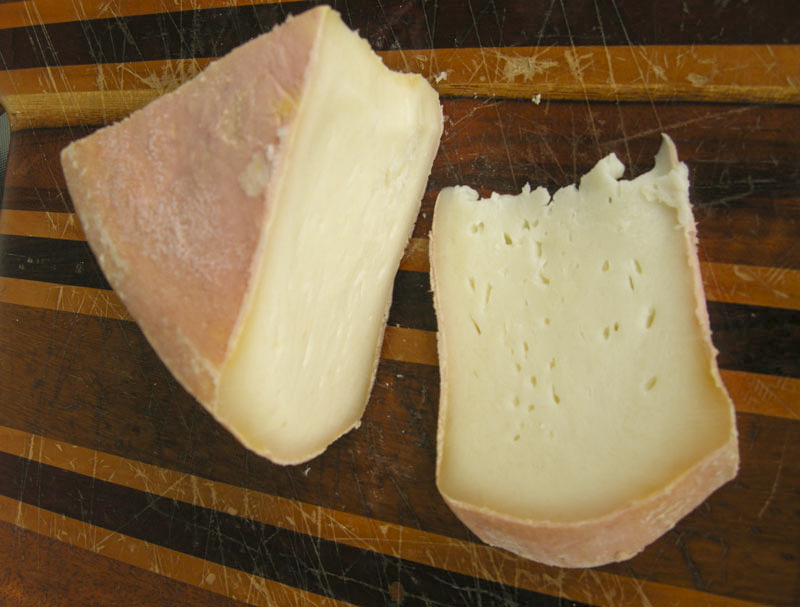Port Salut / Saint Paulin Info
Trappist Style Cheese, Port Salut or Saint Paulin
Port Salut / Saint Paulin is a fun cheese to make, especially in the summer season because it goes really well with beer and BBQ.
It's a semi-soft cheese that expresses the richness of summers bounty with a rich creamy flavor and smooth texture. This cheese was developed long ago by the Trappist Monks and goes by the name of 'Port du Salut' (the Gates of Salvation), but is also known as 'Saint Paulin' in another derivation. Essentially they are both the same cheese.
What is Port Salut / Saint Paulin
The 'Trappist' style cheese is one with a semi-soft body and is usually ripened with a washed or smeared rind resulting in a yellow to orange rind. Unfortunately, the commercial versions today are made with an orange dye sprayed onto the surface at the end of the ripening process.
The traditional ripening is due to a series of light brine washes which selects for a specific bacteria (coriniforms including B.linens) that naturally produces a rather colorful surface and is actually responsible for producing enzymes that cause the cheese to ripen to the center producing a very soft and aromatic cheese.
This cheese process is somewhat similar to the more "aromatic" cheeses, such as Limburger, but is much milder due to a more restrained ripening.
The most notable factors in making this cheese are:
- the series of light salt brine washes,which are very important in setting the stage for the special enzyme production which slowly moves towards the center of the cheese.
- the high moisture of the cheese body, which will allow these enzymes to move quickly.
- a high humidity in the aging spaceto keep the cheese surface from drying out.
As the process of ripening progresses, the enzymes begin to break the proteins into smaller and smaller components, thus reducing the acidity and developing flavor in the cheese. As ripening continues, this moves deeper and deeper into the cheese until the entire interior of the cheese has been ripened.
The History of Port Salut / Saint Paulin
The Trappist name was originally given to the monks from the LaTrappe Abbey in Normandy. This Cistercian order is best known for their self sufficiency and production of fine food/beverages within the Abbey grounds. They are known best for their jams, honeys, liqueur, and Trappist beers even today.
Several of these Abbeys had developed through France and the rest of Europe prior to the French Revolution, but with the upheaval of the revolution the monks were forced to leave France (13 February 1790, all religious orders were dissolved). Prior to the French Revolution, the Abbeys were major landholders and supported themselves and their works through the tributes and tithes due these Monastic centers in return for land leases. Cheese was included as payments, as a means to preserve the milk from these leaseholders and hence, the Abbeys did not make it.
The monks from the LaTrappe Abbey fled with their Abbot Dom Augustine de Lestranges to Switzerland. During this exile, they learned the essentials of making this cheese as a means to support themselves. Upon their return in 1815, they brought their cheese making with them and they built the Monastery of Notre Dame du Port du Salut in Entrammes, France. Here, they also began to make and evolve this cheese they had learned to produce in Switzerland. The cheese they produced is naturally named after their monastery. It was these monks that refined the bacterial rinds that now are signature to many of our aromatic cheeses like this. Similar cheeses are collectively known today as Trappist cheeses.
For many years, and well up into the 20th century, Port du Salut was a very respected cheese and sold well in Paris and throughout France. However, the demands of the government to make changes in their production, plus the costs of upgrading their facility, eventually caused the monks to cease producing this cheese. The rights to production were eventually sold to one of the larger cheese factories and the name is still held by them, but the process is much different today (noted primarily by the very orange dyed rinds).
Fortunately for all cheese lovers, the process was also passed on to other Abbeys and Convents and similar cheeses are still made the traditional way in France, as well as in Canada, the US, and Denmark. But that and the stories of it all will be saved for another time. One of the names that evolved was Saint Paulin, since Port Salut was now only available to the new industrial owners.


































